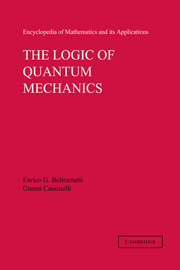Book contents
- Frontmatter
- Contents
- Editor's Statement
- Foreword
- Preface
- The Logic of Quantum Mechanics
- Part I HILBERT-SPACE QUANTUM MECHANICS
- Part II BASIC STRUCTURES IN THE DESCRIPTION OF QUANTUM SYSTEMS
- Part III RECONSTRUCTION OF HILBERT-SPACE QUANTUM MECHANICS
- Appendix A Trace-Class Operators
- Appendix B The Spectral Theorem
- Appendix C Proofs for Chapter 11
- Subject Index
- Miscellaneous Endmatter
Foreword
Published online by Cambridge University Press: 05 June 2013
- Frontmatter
- Contents
- Editor's Statement
- Foreword
- Preface
- The Logic of Quantum Mechanics
- Part I HILBERT-SPACE QUANTUM MECHANICS
- Part II BASIC STRUCTURES IN THE DESCRIPTION OF QUANTUM SYSTEMS
- Part III RECONSTRUCTION OF HILBERT-SPACE QUANTUM MECHANICS
- Appendix A Trace-Class Operators
- Appendix B The Spectral Theorem
- Appendix C Proofs for Chapter 11
- Subject Index
- Miscellaneous Endmatter
Summary
For many years the physical interpretation of quantum theory has been dominated by the “wave-particle duality” attitude of the “Copenhagen school.” This point of view is eloquently described in Bohr's collection of essays on the subject. Despite persistent concerns with apparent paradoxes and limitations to this interpretation (as exemplified by Schrodinger's cat, the paradox of Einstein, Podolsky and Rosen, among others), the Copenhagen view persists de facto in the daily life of the modern physicist. Traditional quantum theory has so successfully explained such a vast amount of data in atomic and molecular physics, solid state physics (and to a lesser extent, elementary particle physics) that little doubt can exist concerning its essential validity.
As a consequence of the overwhelming practical success of the “Copenhagen interpretation, ” the latter has acquired the status of dogma. For many years, therefore, most physicists have found it expedient to relegate the puzzling aspects of the theory to philosophers, and mathematicians. Nevertheless, a persistent interest in this subject has produced a significant and fascinating literature, reviewed by Jammer. In recent years, concerns over the proper meaning to be ascribed to quantum theory have produced an increasingly deep and incisive series of investigations.
These investigations fall generally into two categories: either (1) discussion of the philosophical content of the theory, or (2) analyses of the mathematical variants of the theory and their connection with differing interpretational schemes. Physicists tend to be detached from a commitment to philosophical issues, because of their realization of the transient character of the meanings attached to theories of the day. As a simple illustration of this we can mention the profound differences between nonrelativistic and relativistic quantum mechanics.
- Type
- Chapter
- Information
- The Logic of Quantum Mechanics , pp. xix - xxiiPublisher: Cambridge University PressPrint publication year: 1984

